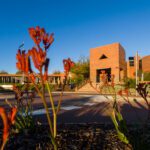New research from Curtin University has found commercial tree crops do more than diversify farmers’ incomes in the Western Australian Wheatbelt, by providing valuable habitats for regionally declining bird populations.
Research recently published by Dr Aaron Gove, Adjunct Research Associate in Curtin’s School of Environment and Agriculture, which compared various native tree crop systems, showed woodland birds were using the tree crops as habitat.
Dr Gove said the findings provided a basis for the future direction of tree crop plantings for areas where threatened bird and insect species need to be protected.
“These are exciting findings, as not only is this a great sign that Wheatbelt farmers can increase the habitat value of their farms while diversifying their incomes, but it also supports research from the east coast of Australia showing woodland birds returning to farms as farm management improves,” he said.
“We now have evidence of the critical role tree crops can play in providing a buffer against bird declines.”
The aim of Dr Gove’s research is to compare the habitat value of sandalwood and brushwood systems with that of native woodlands and annual crops, using bird and insect species as potential indicators.
Habitat diversity was assessed in three locations across the Wheatbelt near Wongan Hills, Northam and Arthur River. Birds and insects were surveyed at each site and their relationship with habitat diversity assessed and statistically analysed. Results revealed that brushwood and sandalwood sites supported a wide diversity of woodland bird species.
Dr Gove said the findings for insects were also interesting.
“While wasps and bees are considered an essential natural predator for biological control of crop pests, they did not demonstrate a preference for any particular habitat, other than where their prey could be found,” he said.
Dr Gove said the research highlighted the importance of structural habitat elements provided by tree crops, and this may be more important than the range of species included in the tree crop mix.
“This finding underlines the importance of structural diversity and its association with bird species richness and also highlights the need to conduct more research into wasp diversity and their habitat requirements,” he said.
For more information or to obtain a copy of Dr Gove’s research report: The habitat value of indigenous perennial tree crops in the Western Australian Wheatbelt, visit http://www.avongro.com.au/Webpages/news.htm.
This research was funded by Lotterywest and supported by Curtin University and Avongro Wheatbelt Tree Cropping Inc.
Contact:
Dr Aaron Gove, Adjunct Research Associate, Dept of Environment & Agriculture
Tel: 08 9266 9674, Email A.Gove@exchange.curtin.edu.au
Megan Meates, Public Relations, Curtin University
Tel: 08 9266 4241, Mobile: 0401 103 755, Email: megan.meates@curtin.edu.au


